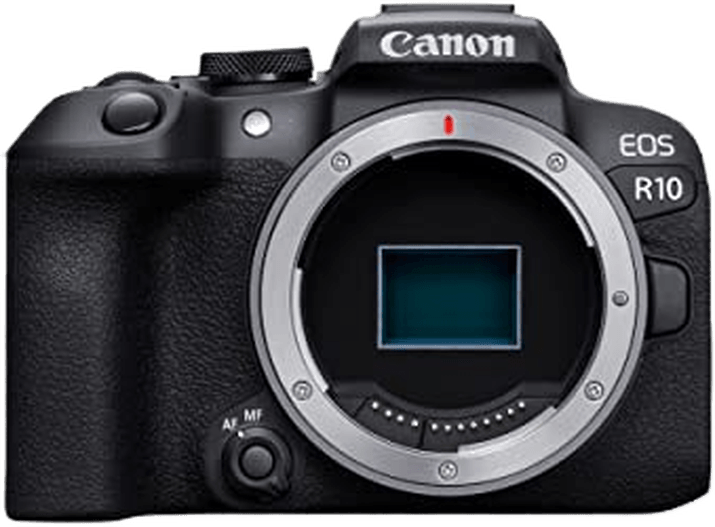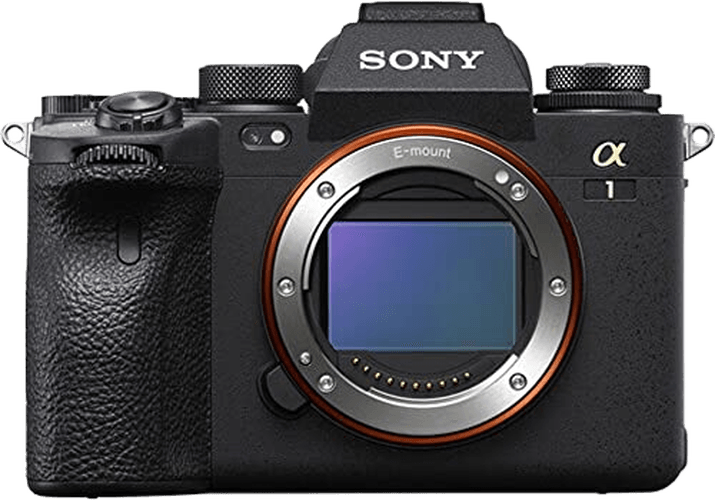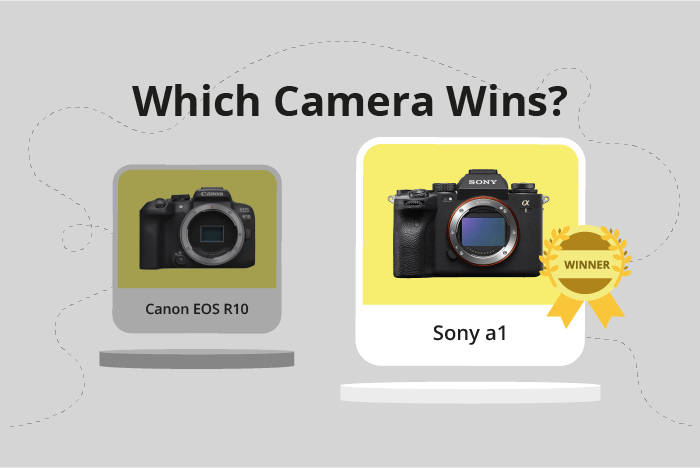Canon EOS R10 vs Sony a1 Comparison
Canon EOS R10

Sony a1

The Sony a1 outshines the Canon EOS R10 with a score of 86/100 compared to 69/100. Both cameras are mirrorless and share similar sizes, with the Sony a1 measuring 129 x 97 x 81mm and the Canon EOS R10 at 123 x 88 x 83mm. However, the Sony a1 is significantly heavier at 737g, while the EOS R10 weighs only 426g.
The Sony a1’s higher score reflects its superior performance and features, justifying its higher launch price of $6,499 compared to the EOS R10’s $980. However, the Canon EOS R10 offers a more affordable option for those on a budget and is lighter, making it easier to carry around.
Considering the scores and specifications, the Sony a1 is the better camera for those seeking top-notch performance, while the Canon EOS R10 provides a budget-friendly and lightweight alternative.
Canon EOS R10 vs Sony a1 Overview and Optics
The Sony a1 takes the lead in our optics comparison with a score of 89/100, while the Canon EOS R10 lags with a score of 71/100. Both cameras share some common specifications, such as CMOS sensor type, but differ in various aspects that contribute to their overall performance.
In terms of similarities, both cameras are equipped with CMOS sensors and have their respective lens mounts, with the Canon EOS R10 featuring the Canon RF mount and the Sony a1 using the Sony FE mount. Additionally, both cameras use powerful processors: the Canon EOS R10 has the Digic X, while the Sony a1 employs the Dual Bionz XR.
The Sony a1 excels with its higher megapixel count of 50.1, allowing for greater detail and resolution in images. Its shooting speed of 30 frames per second (fps) is also impressive, enabling the capture of fast-moving subjects with ease. Moreover, the Sony a1 boasts a full-frame sensor, resulting in better low-light performance and increased dynamic range. A notable advantage of the Sony a1 is its in-built image stabilization, which helps reduce camera shake and improve image sharpness.
On the other hand, the Canon EOS R10 has a lower megapixel count of 24, which may be sufficient for general photography but might fall short for professionals seeking high-resolution images. Its shooting speed of 15 fps is slower than the Sony a1, potentially limiting its ability to capture fast action. The Canon EOS R10 uses an APS-C sensor, which is smaller than the Sony a1’s full-frame sensor. Lastly, the absence of image stabilization in the Canon EOS R10 could be a disadvantage for photographers who require steady shots.
Taking these factors into account, the Sony a1 emerges as the superior camera in terms of optics. Its higher resolution, faster shooting speed, full-frame sensor, and image stabilization contribute to its higher score and better performance. The Canon EOS R10, while still a capable camera, falls short in these key areas, making the Sony a1 the preferred choice for photographers prioritizing optical quality.
Canon EOS R10 vs Sony a1 Video Performance
The Canon EOS R10 wins in video capabilities with a score of 91/100, while the Sony a1 scores 86/100. Both cameras have impressive video specifications, with certain features in common. They both offer a maximum video frame rate of 120fps, ensuring smooth and high-quality slow-motion footage.
However, the Canon EOS R10 outperforms the Sony a1 in some aspects. The R10 has built-in time-lapse functionality, which provides a convenient way to create stunning time-lapse videos without the need for additional equipment or software. This feature makes the R10 more versatile for videographers who want to capture the passage of time in their work.
On the other hand, the Sony a1 has a superior maximum video resolution of 8K, compared to the R10’s 4K. This means that the a1 can capture videos with incredible detail and clarity, allowing for more creative freedom in post-production. However, this advantage may not be as significant for users who do not require such high-resolution footage or lack the necessary equipment to process and display 8K videos.
Despite the Sony a1’s higher video resolution, the Canon EOS R10’s built-in time-lapse functionality and overall higher video score make it the better choice for most videographers. It offers a more well-rounded set of video features, making it suitable for a wider range of projects and creative styles. The Sony a1, while excelling in video resolution, falls short in convenience and versatility due to its lack of built-in time-lapse functionality.
Canon EOS R10 vs Sony a1 Features and Benefits
The Sony a1 emerges as the winner in this comparison, with a feature score of 83/100, while the Canon EOS R10 scores 70/100. Both cameras share several specifications, including a 3-inch screen size, touchscreen capabilities, flip screen, absence of GPS, and the presence of WIFI and Bluetooth.
The Sony a1 outperforms the Canon EOS R10 in screen resolution, offering 1,440,000 dots compared to the 1,040,000 dots of the Canon EOS R10. This higher resolution provides clearer and sharper images on the Sony a1’s screen, which is essential for photographers who need to review their images in detail.
On the other hand, the Canon EOS R10 does not have any significant advantages over the Sony a1. Both cameras have similar features, and the Sony a1 simply offers a better screen resolution. This means that the Canon EOS R10 does not provide any unique or superior features compared to the Sony a1.
After evaluating the feature scores and specifications, it is clear that the Sony a1 is the superior camera in this comparison. Its higher screen resolution offers a notable advantage for photographers who require a clear and sharp display. In contrast, the Canon EOS R10 does not provide any unique features or benefits that make it a better choice than the Sony a1. Thus, the Sony a1 is the recommended camera for those seeking a high-quality camera with excellent features.
Canon EOS R10 vs Sony a1 Storage and Battery
The Sony a1 outperforms the Canon EOS R10 in storage and battery, with a score of 73/100 compared to the R10’s 40/100. Both cameras support USB charging and accept SD memory cards. However, the Sony a1 surpasses the Canon EOS R10 in several aspects.
The a1 has two memory card slots, while the R10 only has one. This offers photographers increased storage capacity and backup options. Additionally, the a1 accepts both SD and CFexpress Type A cards with UHS-II compatibility, providing faster read and write speeds.
In terms of battery life, the Sony a1 also takes the lead. It delivers 530 shots per charge compared to the Canon EOS R10’s 450 shots. The a1 uses the NP-FZ100 battery, which lasts longer than the R10’s LP-E17 battery.
The Canon EOS R10, however, supports UHS-I compatible memory cards, which may be more affordable for some users. Despite this advantage, the Sony a1’s superior storage and battery capabilities make it the better choice for photographers who require extended shooting sessions and faster memory card performance.
Canon EOS R10 vs Sony a1 – Our Verdict
Are you still undecided about which camera is right for you? Have a look at these popular comparisons that feature the Canon EOS R10 or the Sony a1:

